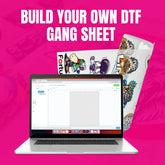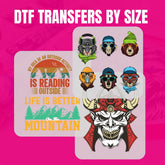Iron On Transfers vs. DTF Transfers: Which is Better?
Fabric printing has evolved, and now there are several methods to get excellent designs for apparel. Iron on transfer and DTF transfer are two somewhat common techniques. Although both let consumers design personalized clothing, their applications, durability, pricing, and general efficiency fluctuate significantly. Whether you are an individual designing custom design or a company trying to grow, knowing which transfer technique fits your situation is crucial. We shall carefully break down the differences in great detail in this article so you may decide with understanding.
Understanding Iron On Transfers
For years, iron-on transfers have been a common technique for patterning fabric. A design is printed onto transfer paper, then laid on the cloth and heated with an iron or heat press. The heat on the paper activates the adhesive, binding the design to the fabric. Although this approach is easily available to novices and does not call for costly tools, it has significant disadvantages.
Understanding DTF Transfers
A more recent development that has transformed fabric printing is DTF, sometimes known as direct-to-film transfer. Unlike iron-on transfers, which depend on an adhesive coating, DTF transfers specialized inks onto PET film. After that, heated adhesive powder is sprayed over the design and pressed onto the cloth. The end effect is a vivid, long-lasting print that is resistant to several washes without cracking or fading.
Durability: Which Lasts Longer?
Durability is really important between iron-on transfers and DTF transfers. Particularly after several washings, iron-on transfers usually break down fast. Because they depend on a heat-activated adhesive layer, the bond degrades with time and causes fading and peeling.
Conversely, DTF offers exceptional durability and is ready to press. Studies reveal that DTF transfers resist over 50 wash cycles without losing brightness. DTF's glue produces a stronger bond with the cloth, preventing fading, peeling, or splitting.
Application Process: Which is Easier to Use?
The simple application of an iron on decal makes it a preferred tool for enthusiasts. You just need a household iron, transfer paper, and a steady hand. Nevertheless, variations in temperature and pressure might influence the outcome, causing unequal transfers.
DTF transfers require specialist tools like a heat press and a PET film handheld printer. Although the initial configuration could seem complicated, the real application process is faster and more dependable. The exact adhesion of DTF guarantees that the design completely blends with the cloth, therefore offering a professional-grade finish.
Cost Comparison: Which is More Affordable?
Iron-on transfers are the superior alternative if you're trying to save money. The supplies needed, transfer paper and an iron, are cheap and readily available. Trade-offs in durability and quality accompany the reduced cost, too.
Because DTF transfers require a printer, PET film, and adhesive powders, upfront expenditures are higher. However, for companies manufacturing a lot of tailored clothing, DTF printing can, over time, be more reasonably priced. DTF prints endure longer and preserve quality, reducing the need for regular reprints and saving money.
Fabric Compatibility: Which Works on More Materials?
Iron-on transfers are one of the main restrictions in fabric compatibility. They suffer with synthetic materials like polyester or spandex but perform best on cotton. This limits the range of things that iron-on decals allow to be personalized.
DTF transfers, nevertheless, provide far more flexibility. They can treat cotton, polyester, mixes, and non-traditional surfaces like leather. Therefore, DTF transfers are perfect for companies expanding their product lines.
Print Quality: Which Produces Better Images?
DTF transfers offer a benefit in print quality. DTF printing's sophisticated ink technique generates brilliant colors with exact details. DTF prints also feel silky and go well with the cloth.
By comparison, iron-on transfers sometimes leave the fabric with a thick, plastic-like feel. Particularly with regular washing, the color brightness could fade over time. DTF is the better option for individuals looking for professionally graded prints.
Conclusion
Your particular requirements will determine which iron-on transfer and DTF transfer best suit you. Decal transfers might be a basic yet reasonably priced fix for do-it-yourself projects. DTF transfers are the preferable choice if you want vivid, long-lasting prints suitable for several materials. Ideal for both enterprises and hobbyists, DTF transfers provide exceptional durability, improved print quality, and more fabric compatibility.
For high-quality DTF transfers ready to press, visit DTF Transfer Art and explore a wide range of customizable printing solutions.
- custom apparel printing
- Custom clothing printing
- custom gangsheet
- Custom Gangsheets
- custom prints
- decal production
- decal transfer
- decal transfers
- Digital printing
- Direct-to-Film Transfer
- DTF gangsheet
- DTF Heat Press
- DTF Printing
- dtf transfer
- dtf transfer art
- dtf transfer film
- dtf transfer instructions
- dtf transfer paper
- dtf transfer printer
- dtf transfer sheets
- dtf transfers near me
- dtf transfers ready to press
- dtf transfers wholesale
- DTF vs Screen Printing
- DTF vs Vinyl
- DTF vs. iron-on
- gangsheet printing
- heat press printing
- heat transfer decals
- heat transfer method
- hot peel DTF
- iron-on decals
- Printing companies
- Printing methods
- Quality printing
- Sublimation printing
- Transfer printing
- vinyl decals






